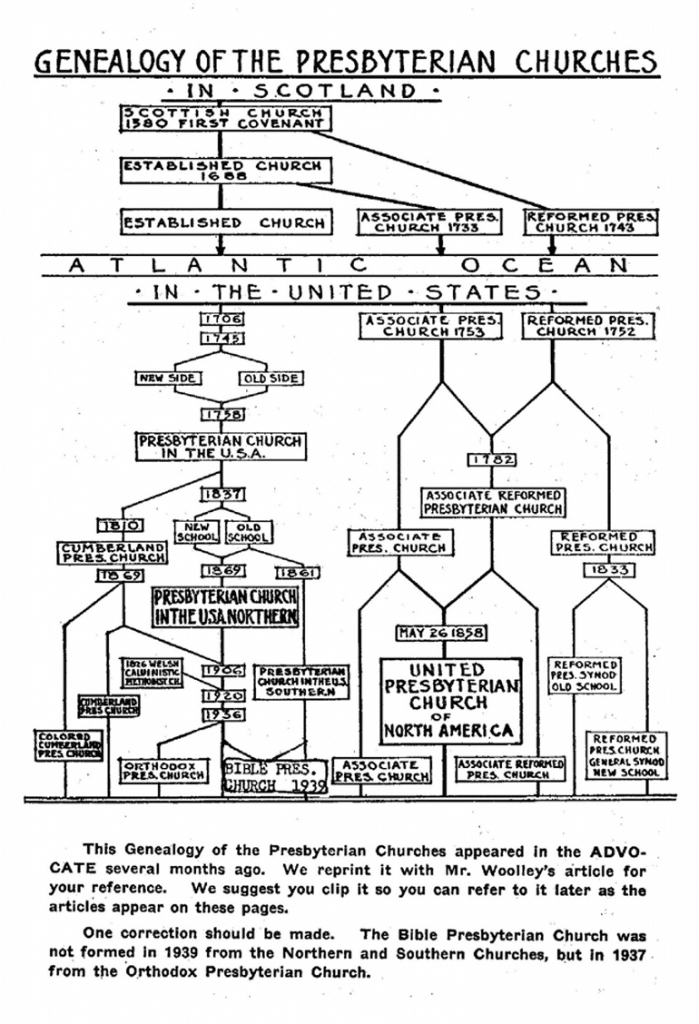We continue today with Dr. Woolley’s series of articles on Presbyterians in America. Do keep in mind that these articles were written in the early 1950s and so much has changed since that time. Tomorrow’s post will focus on the Orthodox Presbyterian Church and the Bible Presbyterian Church.
Presbyterians in America
by Rev. Paul Woolley
IV – Cumberland Presbyterians
[Reformed Presbyterian Advocate, 86.1 (January 1952): 1-2.]
At the end of the America Revolution, this country entered upon a period of tremendous expansion. Thousands crossed the Appalachian Mountains to settle in the Middle West. There they found almost no churches. What could they do? The Methodists sent circuit riders throughout the area. The Baptists had hundreds of backwoods preachers. In neither instance were these men well-educated, or adequately prepared for a proper ministry. The Presbyterian Church had not enough men for its settled congregations. How meet the need? Some Presbyterians who settled in Kentucky said, We can find enough exhorters. They have not had any appreciable education and they are not entirely in accord with Presbyterian doctrine. But they will fill the gap.
So these Kentuckians asked the Presbyterian General Assembly for permission to ordain men who did not meet the educational standards of the Form of Government of the Church. The debate was earnest, but the Assembly decided that that was not the honest way to meet the need. After waiting some years, the patience of one Kentucky Presbytery wore out. It felt it must provide more ministers, and proceeded to ordain men who did not meet the requirements. After being dissolved for disregard of the standards of the Church, it reconstituted itself as an independent Presbytery, and thus brought into existence, in 1810, the Cumberland Presbyterian Church.
The Church revised the Westminster Confession in order to remove statements about phases of God’s gracious election. They objected particularly to the notion of reprobation. Thus the Cumberland Church attracted to it persons who tended toward an Arminian theology but who liked Presbyterian principles of worship and government. It became a large Church in the southern part of the United States and at the beginning of the twentieth century had about 195,000 members. The great majority of them were in the south central states, though there were some as far north as Pennsylvania and Illinois.
In the early years of the century the Presbyterian Church in the U.S.A. modified its doctrinal standards. It made certain changes in the Westminster Confession. It added two new chapters to the Confession. It adopted an additional Declaratory Statement explaining portions of the Confession. The major changes were designed to explain the Confession in such a way as to make it palatable to the Cumberland Presbyterian Church with its Arminian tendencies. The objective was obtained. The majority of the Cumberland Church agreed to union with the Presbyterian Church in the U.S.A. This was effected in 1906. Thus the so-called Northern Presbyterian Church came to have great numbers of congregations scattered throughout the south in competition with the congregations of the (Southern) Presbyterian Church in the U.S.
A minority of the Cumberland Church refused to enter the union. It was composed of those more consciously Arminian, on the whole, than the unionists. Probably it numbered only about 15,000 people. It constituted itself vigorously, however. Now it has grown into a church of 81,000 members, having congregations as far east as Ohio, as far north as Michigan, and as far west as California. Between 1916 and 1936 it lost ground.
In the last fifteen years, it has more than made up what it lost. Foreign missions are conducted in the Far East and in South America. The foreign missionary budget is about $90,000 per annum. Headquarters of the national activities, which include a large publishing plant, are in Nashville, Tennessee. Affiliated with the Church is Bethel College of McKenzie, Tennessee, co-educational, with four hundred students.
Soon after the Civil War the Negro members of the Cumberland Church organized congregations separate from the white members. Ultimately they sought complete independence, and this was granted by the General Assembly of 1869. Thus began the Colored Cumberland Presbyterian Church. It was not affected as radically by the 1906 union as was the older Church, and continued its organization intact. Its doctrinal principles are similar to those of the other Cumberland Church. Membership figures are available only in round numbers, totaling about 30,000.
Cumberland Presbyterianism is essentially for semi-Arminians. Believing in final perseverance but not in unconditional election, they like Presbyterian government and worship. The question is, however, What does the Bible teach? “To the law and to the testimony! If they speak not according to this word, surely there is no morning for them.” (Isa. 8:20).

